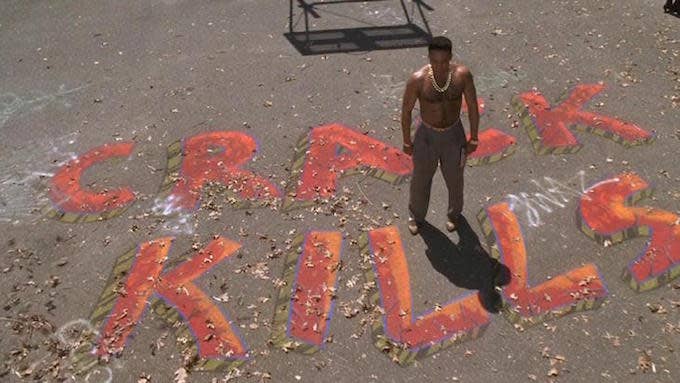
Nostalgia has become exceptionally intoxicating. It provides a high so powerful that Tumblr kids born in the 1990s light up at the sight of (and instinctively reblog) artifacts from an era they’re too young to remember. Some images, characters, and films have potency that spans decades and unites generations. In a quarter of a century, Mario Van Peebles’ anecdotal crack deterrent New Jack City has achieved both.
When New Jack City was released during the first quarter of 1991, the initial Gulf War had just drawn to a close. The war in America’s inner cities, however, remained intense. At the heart of the battle was the creation, distribution, and consumption of crack. Its bleak legacy includes the destruction of communities, and although New Jack City was written as a drug polemic, it doesn’t ignore the systemic factors that made crack so popular, lucrative, and ruinous from the 1980s on. But the true force of New Jack City is best measured over time. A crack high is a short, intense period of relief with the dangerous potential of acute dependency. As the film illustrates, this can make monsters out of humans because when the high fades, an insatiable addiction is left in its place. Just as some addicts never kick the habit, New Jack City’s influence on pop culture has lingered to the point of permanence.
Penetrative fiction finds the perfect medium between drama and real life, then makes a statement within that space. As the first big screen presentation of the crack epidemic and its cascading effects, New Jack City was rooted in that period’s grim realities. Before it affected culture, it absorbed it. A great deal of credit for the authenticity is owed to co-writer Barry Michael Cooper, who used what he saw in his native Harlem as inspiration. Cooper’s first van Gogh was a February 1986 Spin piece on crack, the dirty secret the rest of the media had yet to discover. The following year, he wrote “Kids Killing Kids: New Jack City Eats Its Young” for The Village Voice. It’s no coincidence, then, that New Jack Citybegins in 1986 Harlem with soundbites linking economics and drug-related crime. Cooper observed firsthand how the drug’s bargain prices and accessibility had such rapid and devastating effects. Where the first story focused on crack’s impact on users, the second highlighted an equally deadly consequence: how teenagers in communities ravaged by Reaganomics saw it as an escape.
For one group, the high came expeditiously; for another, the money did. Tragically, the death toll mounted just as quickly on both sides, and these details were taken into consideration in crafting New Jack City. Crack’s negatives are no more apparent today than they were 25 years ago. Whether it’s bought or sold, death was the ultimate price. But limited options and the allure of unlimited earning potential turned teenagers—pre-teens, even—into merchants of death. The misguided pursuit of the American Dream robbed children of their innocence and bred sociopaths. Twenty years before New Jack City’s premiere, Marvin Gaye poetically characterized heroin as the "boy who made slaves out of men." Chris Rock’s doomed Pookie referenced this lyric in the film because, amid this two-decade span, Nino Brown became a malevolent overlord who made crack his conduit for slavery.
Wesley Snipes' Nino Brown was introduced after Tony Montana and before Marlo Stanfield, two names that resonate in pop culture despite resting at opposite ends of the crime boss spectrum. Montana was a walking explosive; Stanfield menacingly icy. Less self-destructive than Montana and more pompous than Stanfield, Brown was the flamboyant super villain elevated to such mythical status that his real name was never uttered. He blended Gordon Gekko’s avarice, Patrick Bateman’s lack of conscience, and the distinct Harlem flair of Nicky Barnes (his loose inspiration) and Frank Lucas. Brown’s ruthless business acumen turned his crew into a criminal enterprise and an apartment complex into a crack operations management center. Meanwhile, he fancied himself an Uptown Robin Hood, handing out Thanksgiving turkeys by day while his operation sold poison around the clock.
Despite traces of fictional and non-fictional figures in his makeup, Brown didn’t represent one person. He was an exaggerated composite of drug-dealers convinced they were anti-heroes raging against a system that failed them, unaware or unconcerned that they’d become idolaters worshipping material possessions and martyred drug dealers as false gods. Aside from Brown, Tony Montana is perhaps the most exalted. Despite its flaws, Scarface’s rags to riches story resonated with a sect eager to rise in similar fashion. Paid in Fullillustrates its popularity with Harlem drug dealers during the early '80s, and New Jack City picks up the baton. Brown is obsessed with Scarface, blind to the fact that he and Montana will meet the same fate. And just as the film channeled elements of pop culture to relay its story, it succeeded in creating its own.
Self-aware due to its creators’ understanding of New Jack City’s world, the film was a sign of the times. The crack era’s styles were on parade: Kangols; fat rope chains; the classic velour adidas sweatsuit. Showing off was a routine exercise, so four-finger dollar-sign rings and gaudy Dapper Dan stylings were the norm. Furthermore, familiarity with the atmosphere and the audience meant New Jack City’s creative brain trust understood the draw of certain faces. From Ice T as a lead to singer Christopher Williams in a smaller, yet still integral role, New Jack City is peppered with cameos relevant to the time. Troop and Levert’s vocals accentuate a montage of Nino and the CMB’s early rise.
Character helped make New Jack Citythe highest-grossing independent film of 1991, and that edge influenced other forms of media. A scene from Martin’s "Suspicious Minds" episode mocked Nino’s interrogation of his CMB subordinates, and the entire display has adopted a new layer thanks to Cooper’s recent revelation that Martin Lawrence was actually cast as Pookie before Chris Rock.
Like Scarface, New Jack City has inspired hip-hop attitudes and countless references. Whenever self-professed "big-mouth Harlem [nigga]" A$AP Rocky refers to himself as a "pretty muthafucka," it’s hard not to picture Nino dismissing Kareem Akbar as the same after assaulting him in the aforementioned scene. Sauce Money connected Scarface and New Jack City ("Al Pacino down to Nino Brown") on Jay Z’s "Bring It On." Jay Z, in turn, spoke to Nino and Gee Money's fraternal bond—and fratricide—on "Anything." Ryan Leslie’s "Addiction" has an allusion, via Fabolous, to Pookie’s "It just keep callin' me" line. Lil Wayne’s The Carter series is a reference to his own last name, as well as CMB’s crack Bastille, and "Single"’s "Nigga had to cancel that bitch like Nino" is a nod to Brown’s vile ousting of his girlfriend, Selina. Even the video for Future’s "Move That Dope" is an homage to New Jack City.
The murdered out attire, huge cell-phones, Ronald Reagan mask, and Jeep Wrangler are overt citations, but the "Crack Kills" graffiti scrawled on a wall is an Easter egg, recalling an infamous shot from New Jack City.

The film's position as source material in the aughts validates its substance. Art has to register on a certain level to evoke nostalgia, so the power rests in the connection. Cooper believes that New Jack City’s legacy resides in a generational search for purpose:
It’s funny how people want to go back to the ’90s and the ’80s now. [People are] trying to explore two [decades before them] to define where [they] are right now. I think New Jack City’s longevity has a lot to do with that. A lot of these [kids] are crack babies. These millennials? They’re crack babies. This sense of spiraling out and trying to find themselves and define themselves, they come from that era. I’m calling them “crack babies” and their parents didn’t necessarily have to use drugs at all. But they came out of a [time] that challenged you emotionally, mentally, and socially. You raise your kids a certain kind of way [because of it].
Twenty years after New Jack City hit theaters, Kendrick Lamar’s Section.80 materialized. On "ADHD," he refers to his generation—the "dysfunctional bastards of the Ronald Reagan era"—as "crack babies." This proves Cooper right: the strength of New Jack City’s legacy lies in its ability to reach those who came of age during that time, those it produced, and those who have learned about it through media. Its presence continues to loom over other parts of society. President Obama's "My Brother's Keeper" initiative was launched to prevent the creation of Nino Browns, so think of it as an answer to Brown's question. The drug epidemics continue, as well. Thirty years ago, it was crack; now it's opiates. (Heroin is back.) New Jack City had popular culture in its system, now it lives on in popular culture’s.

